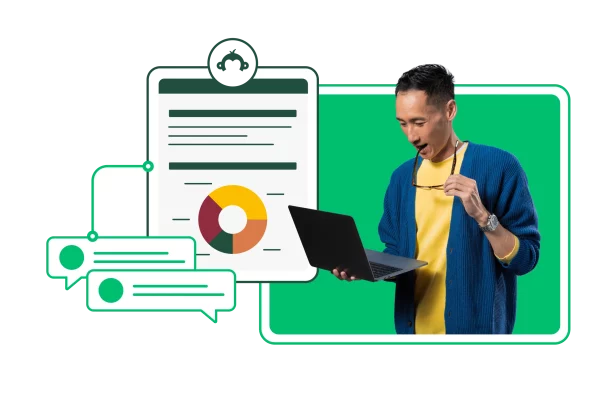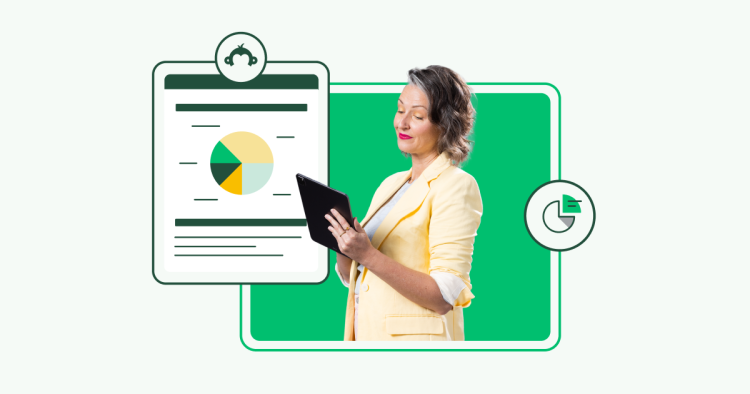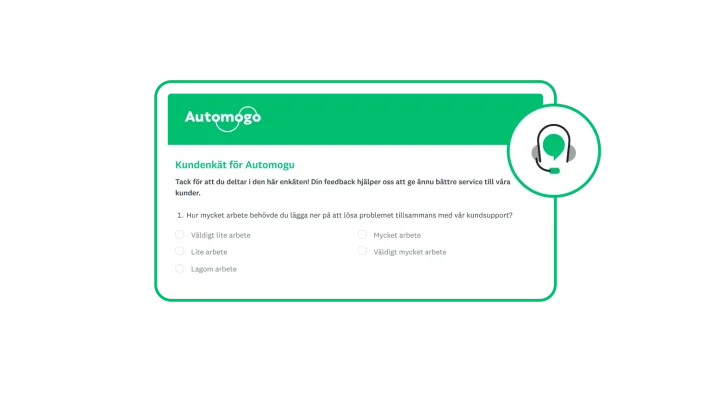Fokusgrupper och enkäter för kund- och marknadsundersökningar

Oavsett om du är ute efter konkurrenskraftiga insikter eller behöver förbättra kundlojaliteten är kundfeedback ett av dina mest värdefulla verktyg.
Varför? Kundfeedback hjälper dig att förstå vad du gör rätt och vad du gör fel, och ger dig den information du behöver för att göra förbättringar. Men det finns olika metoder för att samla in kundfeedback. Du måste välja om du vill använda fokusgrupper eller enkäter.
För att hjälpa dig att bestämma dig har vi tagit fram en guide som beskriver för- och nackdelarna med fokusgrupper och enkäter och när de olika metoderna ska användas för att få kundinsikter.
Vad är en fokusgrupp?
När en researcher skapar en fokusgrupp väljer de noggrant ut några personer som representerar en specifik målmarknad eller användartyp. När fokusgruppen träffas ställer moderatorn frågor och leder en diskussion med gruppdeltagarna. Fokusgrupper är vanligtvis interaktiva och hålls på en neutral plats där de svarande känner sig bekväma med att berätta vad de verkligen tycker.
Per definition är en fokusgrupp utformad för att ge förberedande kvalitativa insikter snarare än övertygande kvantitativa forskningsdata. Det beror på att du inte analyserar en stor datauppsättning. Istället lyssnar du på åsikter, perspektiv och personliga berättelser eller anekdoter. Detta kan ge dig en bättre bild av din kundupplevelse eller målmarknad, men du får inga avgörande bevis gällande den större målgrupp du försöker nå.
Informationen du får från en fokusgrupp kan emellertid ge dig värdefulla insikter i vad dina kunder tycker och varför de tänker som de gör. Med den här metoden kan du utveckla en produkt som passar din marknad, skapa engagerande marknadsföringskampanjer och reagera på förändringar på marknaden.
Vad är en enkät?
Enkäter är en undersökningsmetod som används för att samla in feedback från ett urval personer. De brukar klassificeras som kvantitativa undersökningar, och resultaten kan vara entydiga till skillnad från insikterna från en fokusgrupp.
Med enkäter kan ni ställa frågor och mäta i princip allt. De kan vara korta med bara en fråga eller långa med flera hundra frågor. Svarsformaten inkluderar flervalsfrågor, betygsskalor och öppna frågor.
Enkäter ger stor flexibilitet när det gäller budget och timing. Men de kan också ses som oflexibla, för när du väl har skickat ut en enkät ska du inte göra för många ändringar. Frågorna måste dessutom vara konsekventa för att samla in korrekta data.

Fokusgrupper eller enkäter – vilken ska användas när?
Innan du väljer fokusgruppspanel eller enkät ska du skriva ner dina undersökningsfrågor. Ställ sedan fler frågor om dessa frågor. Med andra ord, fundera på vilken typ av information du skulle behöva för att genomföra den här undersökningen.
- Kan du få tillfredsställande svar med fördefinierade frågor eller skulle det vara bättre att ha ett samtal?
- Vill du testa ett koncept eller en användarupplevelse som kanske kräver mer förklaring?
- Vill du iaktta deltagarnas reaktioner?
- Skulle du vara bekväm med att fatta beslut baserat på några få åsikter?
- Behöver du feedback från ett större provgruppsstorlek för statistiskt signifikanta resultat?
Du kan använda en fokusgrupp för att komma närmare dina kunder eller din målmarknad. Lyssna på vad som motiverar dem, vad de gillar, eller vilka problem de har. Dessa insikter kan hjälpa dig att fatta beslut om din nya produkt eller tjänst, ge dig konkurrenskraftiga insikter eller stärka ditt VOC-program (Voice of the Customer).
Enkäter är ofta kopplade till specifika händelser och du kan analysera underlaget för att göra inriktade, specifika förbättringar i din organisation. Du kan till exempel skicka en kundserviceenkät till kunder som har haft kontakt med kundtjänsten. Den feedback du får kan hjälpa dig att spåra viktig kundservicestatistik och göra inriktade förbättringar.

Fördelar och nackdelar med fokusgrupper och enkäter
Fortfarande inte säker på om du ska använda en fokusgrupp eller enkät? Här är en praktisk lista som hjälper dig att välja metod för din kund- eller marknadsundersökning.
Fokusgrupper
Fördelar
- Du kan lyssna på feedback från kunderna i deras egna ord.
- Du får möjlighet att upptäcka idéer och problem som ditt team kanske inte har tänkt på men som är viktiga för kunderna.
- Metoden erbjuder flexibiliteten att fördjupa frågorna under diskussionen.
- Det går att tydliggöra feedback från kunder genom att ställa specifika följdfrågor.
Nackdelar
- Kostnaderna kan bland annat omfatta rekrytering av deltagare, lokalhyra, moderator- och/eller förmedlingsavgifter, ersättning för medverkan, resor till flera platser för att iaktta grupper med mera.
- Du kan få snedvridna resultat på grund av frispråkiga deltagare som dominerar gruppdiskussionerna.
- Det kan vara svårt att rekrytera kvalificerade deltagare på grund av att fokusgrupper tar längre tid.
- Du behöver investera mycket tid och arbete i planering, organisation, rekrytering och (eventuellt) resor.
Enkäter
Fördelar
- Du får feedback snabbt. Beroende på antalet svarande kan du få resultaten inom 24–48 timmar.
- Det går att ta fram en enkätdesign en gång och sedan skicka samma enkät flera gånger. (Dessutom gör detta det lätt att använda referenspunkter och spåra resultat.)
- Om din enkät tillåter anonyma svar kan deltagarna vara mer benägna att ge dig uppriktig feedback.
- Du kan nå flera kundtyper på samma gång och dela sedan in informationen baserat på valfri variabel.
Nackdelar
- För kund- och marknadsundersökningar kan du få problem med att rekrytera deltagare om du saknar kundernas kontaktuppgifter.
- Du kan inte förtydliga kundernas feedback genom att ställa följdfrågor.
- Deltagarna kanske inte har möjlighet att ge spontan feedback på sådant som inte ingår i enkäten.
- Du har begränsningar för vad du kan fråga eftersom enkätlängden har betydelse. Användare är mindre benägna att ge genomtänkta och fullständiga svar på längre enkäter.
För båda typerna av undersökningar måste du förbereda dig på liknande sätt.
Så här genomför du en undersökning med fokusgrupp eller en enkät
1. Sätt upp mål
Innan du utformar en enkät eller skapar en fokusgrupp måste du sätta upp ett mål för undersökningen. Ditt mål är vad du behöver göra för att gå vidare eller fatta ett beslut.
Genom att skriva ner dina mål (inte för många!) kan du finslipa dina enkätfrågor eller fokusgruppsfrågor. I båda fallen kommer enkätdeltagarna eller deltagarna i fokusgruppen att uppskatta välformulerade och entydiga frågor.
När du definierar dina mål kan du dessutom se till att undersökningen stämmer överens med företagets mål eller relevanta nyckeltal. Det är också en bra idé att samarbeta med interna intressenter för att se till att du ställer frågor som verkligen ger användbar information.
2. Rekrytera deltagare
Vem vill du ska delta i din enkät eller fokusgrupp? Och lika viktigt, vem vill du utesluta?
Deltagarna är avgörande för att undersökningen ska lyckas. Så tänk på deras demografi, inklusive ålder, kön, hushållsinkomst, yrke och var de bor.
Har du deras kontaktuppgifter eller behöver du en panel som hjälper dig att undersöka din målmarknad? Vill du att svarspersonerna eller deltagarna redan ska känna till din produkt eller produktkategori?
Om du behöver hjälp med att hitta rätt personer som kan svara på din enkät kan SurveyMonkey Audience ta kontakt med potentiella deltagare som stämmer in på dina specifikationer.
3. Ta fram en diskussionsguide för fokusgruppen
En diskussionsguide fungerar som ett manus som moderatorn ska använda i fokusgrupper. Diskussionsguiden strukturerar konversationen, för diskussionen framåt, tar upp målsättningarna och engagerar alla deltagare. Innan du skapar en diskussionsguide bör du tänka på följande:
- Vilka frågor vill du att moderatorn ska ställa?
- Vad behöver moderatorn veta om ditt projekt för att kunna svara på deltagarnas frågor?
- Om du testar ett koncept eller en prototyp, vilka ledtrådar eller tips kan moderatorn ge deltagarna?
- Vad bör moderatorn veta om dina undersökningsmål så att hen kan ställa rätt följdfrågor?
Om du jobbar med en researcher bör du börja med målsättningen för fokusgruppen, som ska stämma överens med organisationens mål. Samarbeta med hen för att se till att du ställer frågor på rätt sätt och inte ger gruppdeltagarna för många ämnen eller uppgifter.
4. Skriv bra enkätfrågor
Om du skapar en enkät, följ de här tipsen om hur du skapar bra enkätfrågor och undviker vanliga enkätmisstag:
- Undvik frågor som är ledande eller vinklade.
- Ställ inte två frågor i en.
- Var hänsynsfull om du ställer känsliga frågor i enkäten.
- Använd ett klart och tydligt språk.
- Använd rätt frågetyp.
Kom ihåg att behålla fokus. Ditt mål ligger till grund för frågorna du ställer. Oavsett om du skapar en transaktionsbaserad eller relationsbaserad enkät eller väljer en balans mellan antalet slutna och öppna frågor, måste du alltid ha ditt mål i åtanke.
Om du behöver hjälp med att skapa tillförlitliga enkäter och frågor kan du använda våra expertutformade enkätmallar. Eller prova Bygg med AI, som kan skriva hela enkäten baserat på din prompt.
5. Överväg att förbereda deltagarna i fokusgruppen
För att få ett givande fokusgruppssamtal bör du överväga att förbereda deltagarna. Förberedelser kan fastställa förväntningar så att deltagarna känner sig bekväma med att delta i ett gruppsamtal.
Deltagarförberedelser kan se ut så här:
- Informera deltagarna om plats, tid och längd på fokusgruppens diskussion.
- Informera deltagarna om samtalsämnen.
- Förklara eventuella regler och policyer, inklusive sekretessavtal.
Behöver deltagarna göra någon aktivitet eller förberedande övning innan undersökningen startar? Överväg att schemalägga ett telefonsamtal eller skicka ett mejl för att informera deltagarna innan fokusgruppen äger rum.
6. Avsätt en budget för ersättning
Väg upp för- och nackdelarna med att uppmuntra kunderna att delta. Hur mycket, om något, kan du ge deltagarna i ersättning? För längre enkäter eller fokusgruppsdiskussioner som tar en timme eller mer kan du överväga att ge deltagarna ett presentkort.
Kom ihåg att du måste vara försiktig med hur mycket pengar du erbjuder. Om det är för mycket kan det leda till att människor genomför enkäten eller går med i din fokusgrupp även om de inte är kvalificerade. Om summan är för liten kanske deltagarna inte är motiverade att ge dig genomtänkta svar.
Fokusgrupper eller enkäter i korthet
Som en tumregel kan man säga att det är bäst att välja en fokusgrupp om ni vill ha ett samtal med era kunder som kan ge er vägledning. Om ni däremot vill ha väldefinierade frågor och behöver nå ut till en stor grupp kunder, eller flera grupper, då kan en enkät passa era behov bättre.
Som tur är behöver du inte bara välja en metod för varje projekt. Insikterna som du får från enkäter och fokusgrupper kan komplettera varandra. Enkäter kan ge dig de kvantitativa data och statistiskt signifikanta resultat du behöver för att dra slutsatser. Men fokusgrupper kan ge din målmarknad eller dina kunder en röst och svara på frågan "varför?" bakom dina data.
Undersök din målmarknad med tillförlitlighet
Är du redo att skapa en fokusgrupp eller enkät? SurveyMonkey kan ge dina marknadsföringsundersökningar ett lyft. Testa annonser och nya koncept, övervaka ditt varumärkes hälsa och få insikter från konkurrenterna, för att bara nämna några. Läs mer om att nå din målmarknad.
Hitta fler resurser

Ansvarig inom varumärkesmarknadsföring
Varumärkesansvariga kan använda det här verktygskitet för att förstå målgruppen, få varumärket att växa och förbättra avkastningen.

AI-marknadsföringsstatistik du behöver kunna 2025
88 % av alla marknadsförare använder AI i sina dagliga uppgifter. Upptäck hur marknadsföringsproffs kommer att använda AI 2025 och hur du kan ligga steget före.

Se SurveyMonkeys lösningar för konsumentprodukter och -tjänster
Produkter och tjänster för konsumenter – inklusive snabbrörliga konsumentvaror, resor och hotell – förlitar sig på SurveyMonkey-insikter.

Utforska SurveyMonkeys lösningar för detaljhandeln
Ta reda på hur SurveyMonkey hjälper företag att hitta rätt bland nya marknadstrender, utveckla framgångsrika produkter och skapa omtyckta varumärken.